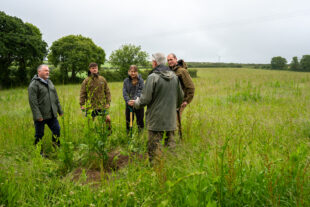https://defrafarming.blog.gov.uk/use-rotational-grazing-on-permanent-grassland/
Use rotational grazing on permanent grassland
The guidance on this page is for SFI pilot participants only. Please visit GOV.UK for the official Sustainable Farming Incentive scheme guidance.
Find out how land managers can increase the number of plant species and improve soil health on permanent grassland by using rotational grazing.
If you’re completing this action as part of the Sustainable Farming Incentive pilot, how you do it is up to you.
The advice on this page can help you get better environmental and business benefits, but you do not have to follow it to get paid.
Rotational grazing on permanent grassland
Permanent grassland is land used for at least 5 consecutive years to grow grasses, legumes, herbs and wildflowers.
Rotational grazing is when you:
- divide a field into smaller paddocks
- frequently rotate livestock around the paddocks
- rest each paddock from grazing, to allow the grass to recover
This differs from set stocking, which is when a fixed number of livestock graze the same field for an extended time without any rest periods.
Benefits of rotational grazing
Rotational grazing:
- increases the quantity of forage, as plants grow more quickly when they’re rested after grazing
- improves soil health, as plant roots grow bigger and increase soil organic matter
- improves soil fertility, as livestock spread manure across the whole field as they move between paddocks
- reduces the need for artificial fertiliser
- reduces the risk of fertiliser runoff into water bodies, which damages habitats and water quality
- reduces feed costs, as you can graze livestock outdoors for longer
Rotational grazing particularly benefits agriculturally improved grasslands. It can provide high-energy forage and reduce fertiliser and herbicide use.
The number of plant species can increase naturally as more species are able to flower and set seed during rest periods. Rest periods can also give you an opportunity to introduce new flower species. You can use the same methods as restoring species-rich grassland.
More plant species gives livestock diverse forage that provides:
- energy from grasses
- protein from legumes
- minerals from herbs or wildflowers
How to use rotational grazing
You’ll need to:
- divide fields into smaller paddocks, for example you might need to regularly move fencing to create new paddocks
- put water in every paddock
- graze each paddock intensively for a short period
- move livestock more often between paddocks, to rest the vegetation from grazing
- let each paddock recover before grazing it again
Match the stocking rate and paddock size to the rate of grass growth and the needs of your livestock. You can use different types of rotational grazing to achieve this, like mob grazing or forward grazing.
Check if you can get funding for new electric fencing equipment.
How to use mob grazing
Mob grazing is a type of rotational grazing that uses a very high density of livestock in a small area for a short time. To do this:
- create a larger number of small paddocks
- move livestock at least once a day
- rest paddocks for longer
How to use forward grazing
Forward (leader-follower) grazing uses 2 groups of livestock with different nutritional needs. Each group grazes a paddock in turn.
- Graze a paddock using livestock with high nutritional needs, like young animals.
- The first group of livestock will graze the highest quality forage.
- Move the first group to a new paddock.
- Now graze the original paddock using livestock with lower nutritional needs.
- Repeat steps 3 and 4 for each paddock you have.
When not to graze
Remove livestock from wet ground to avoid:
- compacting the soil
- poaching the soil and damaging vegetation
To avoid the risk of nutrients running off into nearby sensitive habitats like streams, ponds and bogs, you can remove or use fewer livestock near these habitats.
Weed management
Rotational grazing can help you manage injurious weeds, like docks or thistles. It keeps grassland vegetation dense and allows grass to grow quickly during rest periods. This:
- reduces opportunities for weeds to establish
- weakens weeds that are already present
- reduces the need to use herbicide
Find out how to manage weeds in grassland.
How to tell if rotational grazing is working
You’ll see:
- species of grasses, legumes and herbs or wildflowers
- pollinating insects like bees, butterflies and hoverflies
- different vegetation heights across paddocks, providing shelter for a range of wildlife
- resistance to drought, as deep-rooting plants can access water deep in the soil
You can monitor improvements in soil health using the:
- Agriculture and Horticulture Development Board (AHDB) think soils manual
- AHDB soil health assessment



